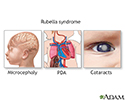Congenital rubella
Congenital rubella is a condition that occurs in an infant whose mother is infected with the virus that causes German measles. Congenital means the condition is present at birth.
Causes
Congenital rubella occurs when the rubella virus in the mother affects the developing baby in the first 3 months of pregnancy. After the fourth month, if the mother has a rubella infection, it is less likely to harm the developing baby.
The number of babies born with congenital rubella is much smaller since the rubella vaccine was developed.
Pregnant women who are not vaccinated for rubella and who have not had the disease in the past risk infecting themselves and their unborn babies.
Symptoms
Symptoms in the infant may include:
- Cloudy corneas or white appearance of pupil
- Deafness
- Developmental delay
- Excessive sleepiness
- Irritability
-
Low birth weight
Low birth weight
Intrauterine growth restriction (IUGR) refers to the poor growth of a baby while in the mother's womb during pregnancy.
 ImageRead Article Now Book Mark Article
ImageRead Article Now Book Mark Article - Below average mental functioning (intellectual disability)
- Seizures
- Small head size
- Skin rash at birth
Exams and Tests
The baby's health care provider will run blood and urine tests to check for the virus.
Treatment
There is no specific treatment for congenital rubella. Symptoms are treated as appropriate.
Outlook (Prognosis)
The outcome for a child with congenital rubella depends on how severe the baby's problems are. Heart defects can often be corrected. Damage to the nervous system is permanent.
Possible Complications
Complications may involve many parts of the body, including:
Eyes:
- Clouding of the lens of the eye (cataracts)
- Damage to the optic nerve (glaucoma)
- Inflammation of the retina (retinitis)
Heart:
-
A blood vessel that usually closes shortly after birth remains open (
patent ductus arteriosus
)
Patent ductus arteriosus
Patent ductus arteriosus (PDA) is a condition in which the ductus arteriosus does not close. The word "patent" means open. The ductus arteriosus is ...
 ImageRead Article Now Book Mark Article
ImageRead Article Now Book Mark Article - Narrowing of the large artery that delivers oxygen-rich blood to the heart (pulmonary artery stenosis)
- Other heart defects
Central nervous system:
- Intellectual disability
- Difficulty with physical movement (motor disability)
- Small head from poor brain development
- Brain infection (encephalitis)
- Infection of the spinal column and tissue around the brain (meningitis)
Other:
- Deafness
- Low blood platelet count
- Enlarged liver and spleen
- Abnormal muscle tone
- Bone disease
When to Contact a Medical Professional
Call your provider if:
- You have concerns about congenital rubella
- You are unsure if you have had the rubella vaccine
- You or your children need a rubella vaccine
Prevention
Vaccination prior to pregnancy can prevent congenital rubella. Pregnant women who have not had the vaccine should avoid contact with people who have the rubella virus.
References
Gershon AA. Rubella virus (German measles). In: Mandell GL, Bennett JE, Dolin R, eds. Principles and Practice of Infectious Diseases . 8th ed. Philadelphia, PA: Elsevier Churchill Livingstone; 2014:chap 154.
Mason WH. Rubella. In: Kliegman, RM, Behrman RE, St Geme JW, Schor NF, Stanton BF, eds. Nelson Textbook of Pediatrics. 19th ed. Philadelphia, PA: Elsevier Saunders; 2011:chap 239.
Reef SE. Rubella (German measles). In Goldman L, Schafer AI, eds. Goldman's Cecil Medicine . 25th ed. Philadelphia, PA: Elsevier Saunders; 2015:chap 368.
-
Rubella on an infant's back - illustration
Rubella is often called three-day measles. Because of the very effective vaccine, rubella is seldom seen today. The rubella vaccine is given in combination with measles (rubeola) and mumps. (Image courtesy of the Centers for Disease Control and Prevention.)
Rubella on an infant's back
illustration
-
Rubella Syndrome - illustration
Rubella syndrome, or congenital rubella, is a group of physical abnormalities that have developed in an infant as a result of maternal infection and subsequent fetal infection with rubella virus. It is characterized by rash at birth, low birth weight, small head size, heart abnormalities, visual problems and bulging fontanelle.
Rubella Syndrome
illustration
-
Rubella on an infant's back - illustration
Rubella is often called three-day measles. Because of the very effective vaccine, rubella is seldom seen today. The rubella vaccine is given in combination with measles (rubeola) and mumps. (Image courtesy of the Centers for Disease Control and Prevention.)
Rubella on an infant's back
illustration
-
Rubella Syndrome - illustration
Rubella syndrome, or congenital rubella, is a group of physical abnormalities that have developed in an infant as a result of maternal infection and subsequent fetal infection with rubella virus. It is characterized by rash at birth, low birth weight, small head size, heart abnormalities, visual problems and bulging fontanelle.
Rubella Syndrome
illustration
Review Date: 4/21/2015
Reviewed By: Neil K. Kaneshiro, MD, MHA, Clinical Assistant Professor of Pediatrics, University of Washington School of Medicine, Seattle, WA. Also reviewed by David Zieve, MD, MHA, Isla Ogilvie, PhD, and the A.D.A.M. Editorial team.


